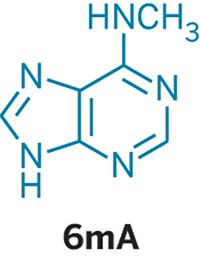Advertisement
Grab your lab coat. Let's get started
Welcome!
Welcome!
Create an account below to get 6 C&EN articles per month, receive newsletters and more - all free.
It seems this is your first time logging in online. Please enter the following information to continue.
As an ACS member you automatically get access to this site. All we need is few more details to create your reading experience.
Not you? Sign in with a different account.
Not you? Sign in with a different account.
ERROR 1
ERROR 1
ERROR 2
ERROR 2
ERROR 2
ERROR 2
ERROR 2
Password and Confirm password must match.
If you have an ACS member number, please enter it here so we can link this account to your membership. (optional)
ERROR 2
ACS values your privacy. By submitting your information, you are gaining access to C&EN and subscribing to our weekly newsletter. We use the information you provide to make your reading experience better, and we will never sell your data to third party members.
Synthesis
A new way to make abiotic methane
This reaction pathway could have been a source of methane before life originated on Earth
by Ariana Remmel
August 3, 2023

Many microorganisms produce methane as a metabolic byproduct. Now researchers have discovered an abiotic process that may have contributed methane to Earth’s atmosphere before life evolved on the planet.
Methane production in methanogenic organisms is generally a specialized process facilitated by genetically encoded enzymes. While there are other ways besides living organisms to make methane, it’s unclear what sources were responsible for releasing methane into the atmosphere before life evolved.
Last year, Leonard Ernst and Johannes G. Rebelein, biochemists at the Max Planck Institute for Terrestrial Microbiology, and their colleagues discovered that even organisms without these methanogenic enzymes can make methane within cells (Nature 2022, DOI: 10.1038/s41586-022-04511-9). This transformation is made possible by the Fenton reaction of ferrous iron (Fe2+) with reactive oxygen species such as hydrogen peroxide. The Fenton reaction generates free radicals that liberate methane and ethane from methylated sulfur and nitrogen compounds. All these materials were likely present on early Earth, Ernst and Rebelein tell C&EN, so they wondered if this nonenzymatic pathway could have played a role in prebiotic chemistry.
To investigate, the researchers created a simplified anoxic chemical system with an aqueous buffer solution at neutral pH supplemented with Fe2+ and dimethyl sulfoxide. Light and heat generate hydrogen peroxide from water, which drives the Fenton reaction.
The team found that its abiotic system not only produced methane and ethane under these simple conditions but also tolerated a more complex mixture of materials. For example, the iron-binding biomolecule citrate increased the reaction rate and promoted the formation of methane from other methylated compounds—such as methionine, 2-(methylthio)ethanol, and trimethylamine (Nat. Commun. 2023, DOI: 10.1038/s41467-023-39917-0). “It appears that this is a quite a robust mechanism,” Rebelein says.
“This is interesting chemistry,” says Paul Bracher, a chemist at Saint Louis University who studies the origins of life. Bracher, who was not involved in the study, says this research demonstrates a mechanism for generating chemical complexity in a simplified abiotic system.
Ernst and Rebelein note that it’s unclear how prominent this reaction would have been in prebiotic chemistry because determining the exact reaction conditions of our young planet is difficult. But methane produced by this pathway could have contributed to atmospheric greenhouse gases that kept early Earth warm enough to host liquid water when the sun was much cooler, they tell C&EN.




Join the conversation
Contact the reporter
Submit a Letter to the Editor for publication
Engage with us on Twitter